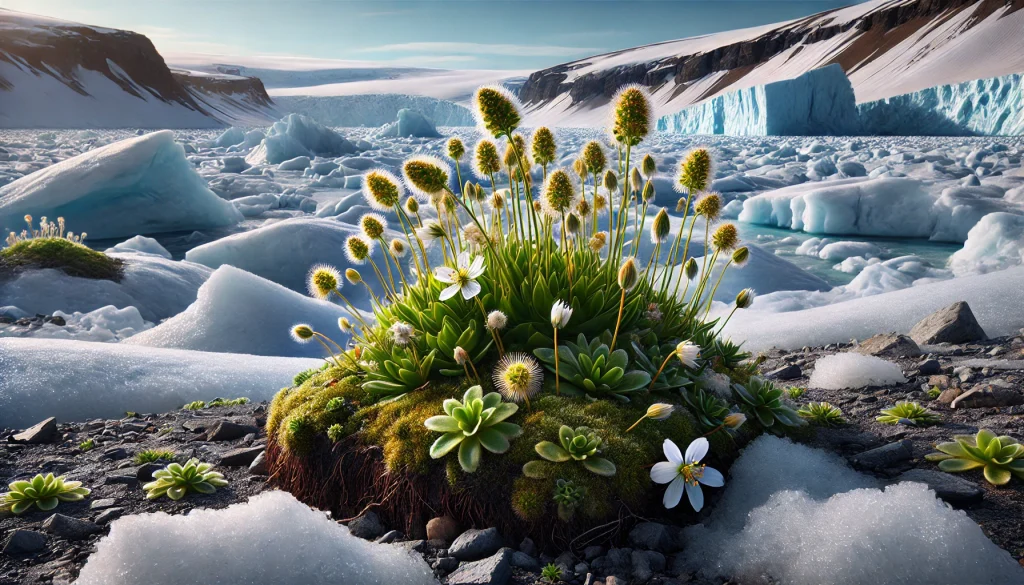Flowers Blooming in Antarctica: A Stark Sign of Global Warming

When we think of Antarctica, we imagine a vast land of ice and snow, the coldest place on Earth where few plants can survive. But recently, something unexpected has happened: flowers are blooming in Antarctica! This surprising event is both fascinating and worrying, as it tells us important things about our planet and global warming.
The Icy Continent Begins to Bloom
Antarctica is known for its freezing temperatures and icy landscapes. It’s so cold that only two types of flowering plants can naturally grow there: the Antarctic hair grass and the Antarctic pearlwort. These plants are tiny and have always grown very slowly because of the harsh, cold environment.
But now, scientists have noticed that these flowers blooming in Antarctica more than ever before. They are growing faster and spreading to new areas. In some parts of Antarctica, the amount of plants has increased by up to 30%! This means that the icy continent is becoming greener, which is something nobody expected.
Also Read-: 3D Print Revolution: How This Technology is Shaping Our Future in Unimaginable Ways
Why Are Flowers Blooming More?
The main reason for this unexpected greenery growth in Antarctica is global warming. But what is global warming? It’s when certain gases in the Earth’s atmosphere, like carbon dioxide, trap heat from the sun. This makes the whole planet warmer over time.

In Antarctica, the temperatures have been rising. Warmer weather means that ice and snow start to melt. When the ice melts, it creates more open ground where plants can grow. Also, with less ice covering the ground, the dark soil absorbs more sunlight, which helps the plants grow even faster. So, the warmer it gets, the more flowers bloom in Antarctica.
Melting Glaciers and Rising Sea Levels
While more flowers might sound like a good thing, there’s a big problem. The same melting glaciers that allow flowers to grow are causing sea levels to rise. Glaciers are huge sheets of ice that have been around for thousands of years. When they melt, all that water flows into the oceans.
Scientists warn that if all the glaciers in Antarctica melted, the sea levels around the world could rise by about 60 meters (that’s around 200 feet)! This would be a serious threat to people living near the coast. Cities like New York, London, and Mumbai could be underwater. This shows how important it is to pay attention to what’s happening in Antarctica.
The Antarctic Treaty System
You might be wondering, can’t we do something to protect Antarctica? Yes! Countries from all over the world have agreed to protect it through something called the Antarctic Treaty System. This is an agreement that says Antarctica should only be used for peaceful purposes. It stops countries from doing military activities or mining there. Instead, scientists are encouraged to study the continent to learn more about it.

Even with this treaty, global warming is still affecting Antarctica. The melting glaciers in Antarctica due to global warming are a big concern. Scientists are working hard to understand these changes so they can help protect our planet.
How Animals Are Affected
The changes in Antarctica don’t just affect plants and sea levels; they also affect the animals that live there. Penguins, seals, and other creatures depend on the icy environment. As the ice melts and more flowers blooming in Antarctica, their homes change. This can make it harder for them to find food and take care of their babies.
For example, penguins build their nests on ice. If the ice melts too early, they might not have a safe place to raise their chicks. This could cause penguin numbers to go down, which would be very sad.
What Does This Mean for the Rest of the World?
The fact that flowers blooming in Antarctica is a sign that our planet is changing. Global warming doesn’t just make Antarctica warmer; it affects the whole world. Warmer temperatures can lead to more extreme weather events like hurricanes, floods, and droughts.
Also, as sea levels rise, people living near the coast might have to move to safer places. This could cause lots of problems, like overcrowded cities and more pollution.
Also Read-: Y Chromosome Disappearance: A Future For Humanity Without Males
What Can We Do to Help?
Even though we’re just kids, there are things we can do to help stop global warming and protect places like Antarctica:

- Save Energy: Turn off lights, TVs, and computers when you’re not using them. Saving energy means less coal and gas need to be burned, which reduces carbon dioxide in the air.
- Walk or Bike: Instead of using a car, try walking or riding a bike when you can. Cars release gases that contribute to global warming.
- Recycle and Reuse: Recycling things like paper, plastic, and metal helps reduce waste and saves energy.
- Plant Trees: Trees absorb carbon dioxide from the air. Planting trees in your community can help fight global warming.
- Tell Others: Share what you’ve learned about flowers blooming in Antarctica and global warming with friends and family. The more people know, the more we can all help.
A Call to Action
It’s important for all of us to take care of our planet. The sight of flowers blooming in Antarctica is a beautiful but worrying sign. It reminds us that climate change is happening right now. We need to work together to make changes that will protect our world for ourselves and future generations.
Why are flowers blooming in Antarctica ?
Flowers blooming in Antarctica primarily due to global warming. As temperatures rise, the icy continent becomes more hospitable for plant life. This leads to an unexpected greenery growth in Antarctica, where the melting of ice provides the necessary conditions for flowers to bloom.
What types of flowers are found in Antarctica?
There are two native flowering plants in Antarctica: the Antarctic hair grass (Deschampsia antarctica) and the Antarctic pearlwort (Colobanthus quitensis). These hardy species have adapted to survive extreme conditions but are now expanding due to the climate change impact.
How is global warming causing greenery growth in Antarctica?
Global warming raises temperatures, leading to melting glaciers and reduced ice cover. This creates more exposed ground for plants, facilitating the greenery growth in Antarctica. Warmer conditions extend the growing season, allowing more flowers blooming in Antarctica.
What is the impact of melting glaciers in Antarctica on sea levels?
The melting glaciers in Antarctica contribute significantly to rising sea levels worldwide. As massive ice sheets melt, they release large volumes of water into the oceans, posing a serious threat to coastal regions through increased flooding and erosion.
How much could sea levels rise if Antarctic glaciers melt completely?
If all the glaciers in Antarctica melted, sea levels could rise by about 60 meters (approximately 200 feet). This dramatic increase would have catastrophic effects on coastal cities and low-lying areas globally.
What is the Antarctic Treaty System, and how does it protect Antarctica?
The Antarctic Treaty System is an international agreement that designates Antarctica as a scientific preserve, prohibiting military activity and mining. It ensures the continent is used for peaceful purposes and protects its environment from exploitation.
Are the flowers blooming in Antarctica a sign of climate change?
Yes, the phenomenon of flowers blooming in Antarctica is a clear sign of climate change impact. The increased temperatures from global warming allow plants to grow in previously inhospitable areas, signalling environmental changes.
Why is the growth of flowers in Antarctica concerning scientists?
The growth of flowers blooming in Antarctica concerns scientists because it indicates rapid environmental changes due to global warming. This unexpected greenery growth could lead to unpredictable ecological shifts and accelerate ice melt.
